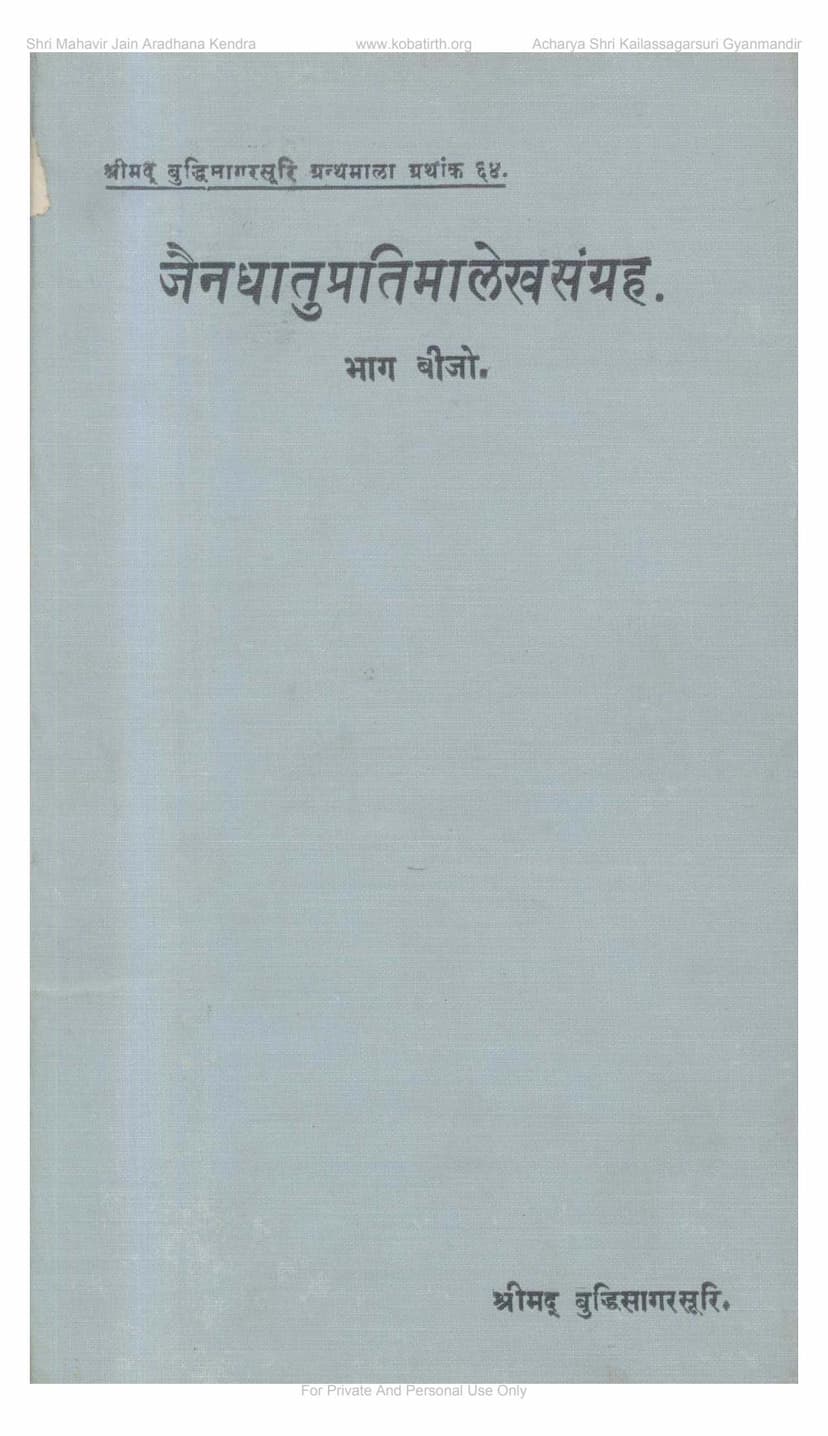Jain Dhatu Pratima Lekh Part 2
Added to library: September 2, 2025

Summary
This text is the second volume of the "Jain Dhatu Pratima Lekh Sangrah" (Collection of Inscriptions on Jain Metal Images), compiled by Acharya Shrimad Buddhisagar Suri. Published by Shri Adhyatma Gyan Prasarak Mandal, it is the 64th publication in the Shrimad Buddhisagar Suri Granthamala.
Here's a breakdown of its content:
Core Purpose: The book is a collection and compilation of inscriptions found on Jain metal (dhatu) and stone (pashan) images. The primary goal is to preserve these inscriptions, which are vital for understanding Jain history, the lives of past Acharyas, the geography of Jain settlements, and the state of Jainism in different periods.
Content Breakdown:
-
Introduction (Nivedan - Page 5): The publishers express regret for the delay in releasing this volume. They highlight the historical significance of these inscriptions, stating that they provide valuable information for historians and shed light on Jain history. They mention the inclusion of inscriptions from Digambara sources, a significant aspect. The introduction also emphasizes the vast number of unrecorded inscriptions remaining on Jain images and calls for financial assistance from prominent Jain institutions and wealthy individuals to continue this work. It acknowledges the arduous efforts of Acharya Shrimad Buddhisagar Suri in compiling these inscriptions despite health challenges. A special thank you is extended to Zaveri Bhuriyabhai Jivanchand of Surat for their financial contribution, with their biography and photo included as a memorial.
-
Preface (Prastavana - Page 6): The preface elaborates on the importance of these inscriptions for understanding the history of Acharyas, regions, cities, and the Jain religion. It notes that while inscriptions from before the Common Era (around 1000 years ago) are scarce, those from the Common Era up to the 19th century are more prevalent. The preface mentions that the first volume contained inscriptions from 54 villages, and this second volume includes inscriptions from 12 additional villages/cities. It acknowledges that complete inscriptions from Ahmedabad, Patan, and Surat are not yet included, but those from specific temples within these cities are. The preface also refers to details about communities following Jainism and the various Gachhas (sects/orders) in earlier volumes. It reiterates the vast scope of remaining work, emphasizing the need for contributions from affluent Jains to make the historical record complete. It also thanks various Munis, Shravakas, and scholars who assisted in collecting and publishing the inscriptions. The hope for a third volume is expressed if divine support and personal strength permit.
-
Biography of Zaveri Bhuriyabhai Jivanchand (Page 9-12): This section is dedicated to the life and contributions of Zaveri Bhuriyabhai Jivanchand, a generous donor who supported the publication. His life is described as virtuous, truthful, philanthropic, and honest in business. He was deeply devoted to Jainism, actively participated in animal welfare activities, and supported the printing of religious texts. Notably, he funded the construction of a Jain Dharamshala in Surat named "Jivan Niwas" in memory of his father, costing Rs. 65,000. He also funded the construction of the "Kankuabai Tower" at the Shri Mahavir Prabhu temple and Dharamshala in Pansar, costing around Rs. 20,000. His charitable activities, business acumen, and commitment to Jain principles are highlighted. His untimely death due to an accident is also mentioned.
-
List of Published Works (Page 13-15): This section provides a catalog of other books published by the Adhyatma Gyan Prasarak Mandal, showcasing their extensive work in Jain literature, including devotional songs (bhajans), spiritual discourses, philosophical treatises, and historical accounts.
-
Detailed List of Inscriptions (Page 17-150): The bulk of the book is this extensive list of inscriptions. It is meticulously organized by:
- Location: It systematically lists villages, towns, and cities where the inscriptions were found. For each location, it often specifies the particular "Pol" (locality or lane) and the specific temple or deity (e.g., Shantinath, Adinath, Parshvanath, Mahavir, etc.) to which the inscription pertains.
- Inscription Content: Each entry appears to provide a transcription of the inscription, often including:
- Samvat (Year): The year in the Vikram Samvat calendar.
- Date: Specific month and day.
- Details of the Donor/Commemorator: Information about the individual or family who commissioned the image or inscription, including their lineage (Gachha, Jati, Gotra), parents' names, and the purpose of the inscription (e.g., for self-benefit, for parents' merit).
- Details of the Image/Deity: The name of the Tirthankar or deity.
- Details of the Acharya/Preceptor: The name of the Acharya or Guru under whose guidance the inscription was made.
- Details of the Installation: Mention of the specific temple or deity.
- "Panchtirthi," "Chovishi," etc.: Indications of the type of installation, referring to sets of Tirthankars.
-
Gachhvar Samvatkramathi Suchi (Index of Acharyas by Gachha and Year - Pages 207-279): This crucial section provides a comprehensive index of the Acharyas whose names appear in the inscriptions, organized by their Gachha (sect) and the Samvat year of their mention. This is an invaluable tool for researchers studying the lineage and chronology of Jain Acharyas. It lists the Acharya's name, the inscription number (Lekhank), and the Samvat year.
Overall Significance:
"Jain Dhatu Pratima Lekh Part 2" is a monumental work of scholarship and preservation. It serves as a primary source for researchers of Jain history, epigraphy, and archaeology. The detailed listing of inscriptions with their context (date, donor, Acharya, location) allows for a deep dive into the social, religious, and economic history of Jain communities over centuries. The inclusion of a comprehensive index of Acharyas is particularly noteworthy, aiding in the reconstruction of Jain lineage and intellectual history. The book highlights the dedication of scholars and institutions like the Adhyatma Gyan Prasarak Mandal in preserving this vital heritage.